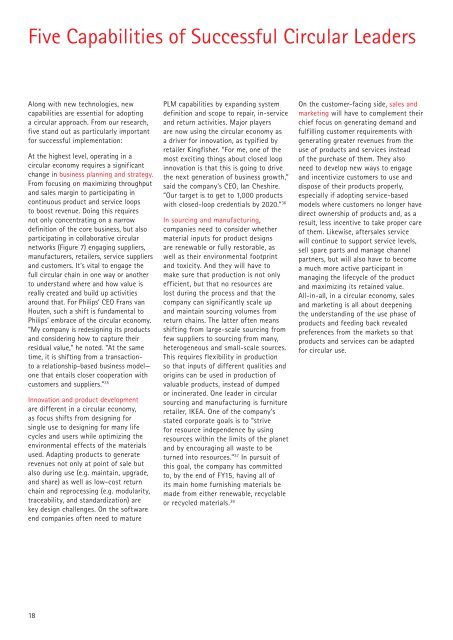Accenture-Circular-Advantage-Innovative-Business-Models-Technologies-Value-Growth
Accenture-Circular-Advantage-Innovative-Business-Models-Technologies-Value-Growth
Accenture-Circular-Advantage-Innovative-Business-Models-Technologies-Value-Growth
You also want an ePaper? Increase the reach of your titles
YUMPU automatically turns print PDFs into web optimized ePapers that Google loves.
Five Capabilities of Successful <strong>Circular</strong> Leaders<br />
Along with new technologies, new<br />
capabilities are essential for adopting<br />
a circular approach. From our research,<br />
five stand out as particularly important<br />
for successful implementation:<br />
At the highest level, operating in a<br />
circular economy requires a significant<br />
change in business planning and strategy.<br />
From focusing on maximizing throughput<br />
and sales margin to participating in<br />
continuous product and service loops<br />
to boost revenue. Doing this requires<br />
not only concentrating on a narrow<br />
definition of the core business, but also<br />
participating in collaborative circular<br />
networks (Figure 7) engaging suppliers,<br />
manufacturers, retailers, service suppliers<br />
and customers. It’s vital to engage the<br />
full circular chain in one way or another<br />
to understand where and how value is<br />
really created and build up activities<br />
around that. For Philips’ CEO Frans van<br />
Houten, such a shift is fundamental to<br />
Philips’ embrace of the circular economy.<br />
“My company is redesigning its products<br />
and considering how to capture their<br />
residual value,” he noted. “At the same<br />
time, it is shifting from a transactionto<br />
a relationship-based business model—<br />
one that entails closer cooperation with<br />
customers and suppliers.” 35<br />
Innovation and product development<br />
are different in a circular economy,<br />
as focus shifts from designing for<br />
single use to designing for many life<br />
cycles and users while optimizing the<br />
environmental effects of the materials<br />
used. Adapting products to generate<br />
revenues not only at point of sale but<br />
also during use (e.g. maintain, upgrade,<br />
and share) as well as low-cost return<br />
chain and reprocessing (e.g. modularity,<br />
traceability, and standardization) are<br />
key design challenges. On the software<br />
end companies often need to mature<br />
PLM capabilities by expanding system<br />
definition and scope to repair, in-service<br />
and return activities. Major players<br />
are now using the circular economy as<br />
a driver for innovation, as typified by<br />
retailer Kingfisher. “For me, one of the<br />
most exciting things about closed loop<br />
innovation is that this is going to drive<br />
the next generation of business growth,”<br />
said the company’s CEO, Ian Cheshire.<br />
“Our target is to get to 1,000 products<br />
with closed-loop credentials by 2020.” 36<br />
In sourcing and manufacturing,<br />
companies need to consider whether<br />
material inputs for product designs<br />
are renewable or fully restorable, as<br />
well as their environmental footprint<br />
and toxicity. And they will have to<br />
make sure that production is not only<br />
efficient, but that no resources are<br />
lost during the process and that the<br />
company can significantly scale up<br />
and maintain sourcing volumes from<br />
return chains. The latter often means<br />
shifting from large-scale sourcing from<br />
few suppliers to sourcing from many,<br />
heterogeneous and small-scale sources.<br />
This requires flexibility in production<br />
so that inputs of different qualities and<br />
origins can be used in production of<br />
valuable products, instead of dumped<br />
or incinerated. One leader in circular<br />
sourcing and manufacturing is furniture<br />
retailer, IKEA. One of the company’s<br />
stated corporate goals is to “strive<br />
for resource independence by using<br />
resources within the limits of the planet<br />
and by encouraging all waste to be<br />
turned into resources.” 37 In pursuit of<br />
this goal, the company has committed<br />
to, by the end of FY15, having all of<br />
its main home furnishing materials be<br />
made from either renewable, recyclable<br />
or recycled materials. 38<br />
On the customer-facing side, sales and<br />
marketing will have to complement their<br />
chief focus on generating demand and<br />
fulfilling customer requirements with<br />
generating greater revenues from the<br />
use of products and services instead<br />
of the purchase of them. They also<br />
need to develop new ways to engage<br />
and incentivize customers to use and<br />
dispose of their products properly,<br />
especially if adopting service-based<br />
models where customers no longer have<br />
direct ownership of products and, as a<br />
result, less incentive to take proper care<br />
of them. Likewise, aftersales service<br />
will continue to support service levels,<br />
sell spare parts and manage channel<br />
partners, but will also have to become<br />
a much more active participant in<br />
managing the lifecycle of the product<br />
and maximizing its retained value.<br />
All-in-all, in a circular economy, sales<br />
and marketing is all about deepening<br />
the understanding of the use phase of<br />
products and feeding back revealed<br />
preferences from the markets so that<br />
products and services can be adapted<br />
for circular use.<br />
18


